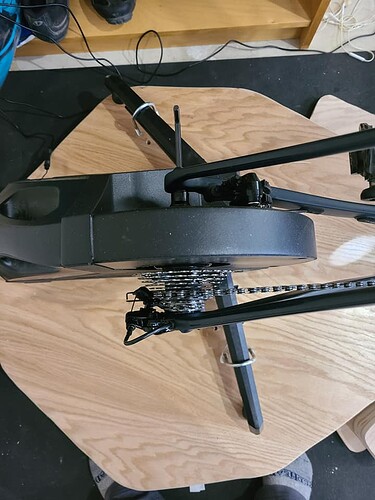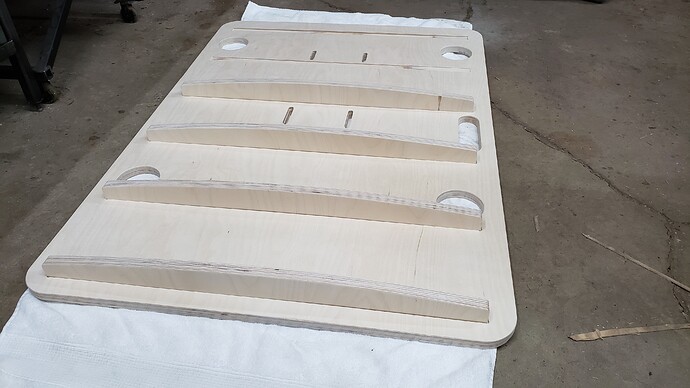Great start! Looking forward to learning more.
Has anyone actually tested the speculated reduced frame stress with a rocker plate? It indeed make sense that allowing a few degrees of lateral movement would reduce the stress on at the bottom bracket and seat stays. However, it would be good to have more than intuition to verify this. Too me it seem a little strange that Saris and Kinect haven’t marketed this aspect of their products, if true.
Perhaps an cyclist engineer with CAD/SimScale experience can do some FEA? Too bad that I’m just a mere data scientist or I would do it myself.
Just speculation at this point, AFAIK. I’ve seen no data or testing shared publicly.
I’m no engineer, just a mechanical designer with enough training to be dangerous. ![]() I’ve discussed it with a few engineers at work (some are also riders) and we all have the same engineering guess that stress is likely reduced.
I’ve discussed it with a few engineers at work (some are also riders) and we all have the same engineering guess that stress is likely reduced.
I have access to SolidWorks and FEA, but am not an avid user. We also have the statics version, not the more advanced dynamics one, so I don’t know if I can add much via that tool, unfortunately.
I’ve considered trying to measure deflection of and between frame members in static and rocker versions, but I don’t know if that has enough fidelity to capture the small deflection differences that might exist.
Using strain gauges would be ideal, but I have limited experience with them other than pre-built load sensors.
Essentially, to do this with any level of accuracy that people would take seriously will take some time, money and skills I don’t have. ![]()
I wouldn’t take the lack of data from the makers as any kind of sign. Honestly, I am still shocked at what I see as a total failure of marketing by them. They can’t even seem to really identify and share the most common benefit to trainer motion, comfort. At least I have published something on that via my saddle pressure mapping video. Its far from perfect (one biased sample), but they should be doing snd showing that on a much larger basis. All that to say, their failure doesn’t mean there is no benefit to be had.
Just finished this. Used Lacrosse balls and tennis balls along with bungee cords to pull it when it moves forward and back. Bungees are noisy so I need to tape up the attachement points. I will also need to stretch out bungee cords shortly as they were brand new and will stretch. I will probably switch to the old rubber bungees as they wont stretch over time. I’m thinking it was around $130 Canadian.
Most of my rockers are made with reclaimed pallets. ![]()
Thanks! That’s good to hear.
I’m really hoping to get my plates rockin later today/tomorrow. Had to fix the paincave door first, couldn’t get in or out.
I whipped up another rocker plate for a co-worker. She’s ridden through a few trainers as a dedicated triathlete and is now on a spin bike as a result. She’s been having hip flexor issues which led me to offer a rocker to try and see if it helps at all. Covid friendly pickup too.
No reports yet on the feel but she’s pretty happy for fit to start with.
Looks great! Is there a pivot or support in the center, or just suspended by the 4 balls?
This is all rocker, I’ve found it to be a really simple method to achieve the movement without any extra hardware needs. The balls are just for the limits and cushion in the lean like you know already.
This is 18mm baltic birch plywood, with 6 rockers to help with the 90lbs spin bike.
Also goofing with a logo for our northern city for some fun.
That is great!, Thanks for the details and additional pics.
I love rib rockers for general simplicity. The feel is amazing for how little there is in them.
Your logo is quite cool too. ![]()
Just to try and increase your sales…if the CNC machine could add a name or initials without weakening…
Had an Omnirocker delivered and setup by Martin today. Brilliant service and it works brilliantly. Can really feel a difference in my core afterwards.
Right on! I love Martin and his designs. Some of the cleanest builds out there. ![]()
Congrats and let me know if you have any setup and use questions.
@mcneese.chad Have you seen/heard anything regarding the Velocity Rockers? Looking at the youtube links, it appears these are new this year. It looks like it does what the Omnirocker does but with 2 plates of wood, instead of 3.
I have minimal knowledge about them. The owner contacted me a while ago and mentioned he would be starting a biz. He got back to me recently after officially launching, and I added them into my Sellers section. I have skimmed the site and like the general info I see.
- Yes. Without pics, I am guessing, but this looks to be a “linear bearing” rocker plate. It uses a shaft with bearings that allow for typical rotation (rocking direction) as well as linear translation (fore-aft movement).
- There are many build like this in the DIY section of the FB group. It’s a generally accepted design and one that works well from what I have seen. There may be some slight differences when compared to a 3 deck system, but it is likely splitting hairs for most riders.
Overall, I think it seems like a good option.
Indeed, Velocity Rockers is a new venture. As the owner, I will be happy to answer any questions you have about the Velocity Rocker product. The other commercial offerings do not have the same functional specs as the Velocity Rocker at this price range or are mass-produced and rebranded in Asia for sale there and abroad. The Asian models use inferior wood for the deck and a simplistic design. I own one, the Lifeline version. My wife and I bought it when we first were introduced to the product type as a solution to my sore arse. The wood platform is adequate but not nearly as robust as the baltic birch I am using. I find that the better plywood coupled with the rod and bearing design gives the top plate a very rigid spine that completely flattens the board out from the back to the front. The curvature of the sides provides rigidity at the periphery. IMO there is a subtle but huge difference in the ride feel of having fore/aft motion when spinning and an even more dramatic effect when climbing or sprinting. Basically, I aim to provide customers with what I made for myself, a superior product for the price, with some added features thrown in! Contact me at info@velocityrockers.com if you have any questions. Ride on!
I just read an article for the new (not yet on the website) KOM Cycling RPV2 - the double decker design looks pretty wild
[Link is to Swiss Cycle review]
Yeah, BikeRumor posted that a day or so ago, and got told to pull it down, by KOM Cycling. Supposed to be officially official next week apparently. Someone else didn’t get the memo ![]()
Again, this is a rebrand of the triple deck design that RideNow has shown on their media channels. It is similar to the Omni-Rocker mentioned above with a separate pair of plates (one shared) for each direction of motion. Works and has some potential advantages, but I dislike the big increase in weight and total stack height.
https://www.instagram.com/p/CL36aFwlNw9/?utm_source=ig_web_copy_link
https://www.instagram.com/p/CIAGNFTAzG2/?utm_source=ig_web_copy_link
Agreed. Plus I worry about the reliability of that middle layer. It seems overly complicated.









